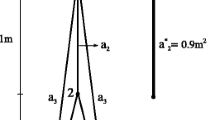Abstract
Approximate reanalysis methods provide effective processes to achieve structural approximate responses without solving the complete set of modified implicit analysis equations. This paper presents methods for carrying out approximate reanalysis of 2D and 3D trusses. Apparently, for the first time, the simultaneous modifications in topology, geometry and size of the structures are taken into account. Three numerical methods, namely, combined approximation, rational approximation and Sherman–Morrison–Woodbury approximation (SMWA), are analyzed and compared for this purpose. The flowchart corresponding to each scheme is presented. Design variables considered are nodal coordinates and cross sectional properties. Moreover, an arrival with bounds between zero and arbitrary amounts includes the variations of the variables. Unlike most works, large trusses with many members are analyzed as numerical examples. Based on obtained outcomes in the several instances, a comparison is conducted between the three schemes and benefits and drawbacks of each method are thoroughly discussed.













Similar content being viewed by others
References
Materna D, Kalpakides VK (2016) Nonlinear reanalysis for structural modifications based on residual increment approximations. Comput Mech 57:1–18
Jian-june H, Xiang-zi C, Bin X (2015) Structural modal reanalysis for large, simultaneous and multiple type modifications. Mech Syst Signal Process 62–63:207–217
Zheng SP, Wu BS, Li ZH (2015) Vibration reanalysis based on block combined approximations with shifting. Comput Struct 149:72–80
Song Q et al (2015) Application of Sherman–Morrison–Woodbury formulas in instantaneous dynamic of peripheral milling for thin-walled component. Int J Mech Sci 96–97:79–90
He JJ, Jiang JS, Xu B (2007) Modal reanalysis method for structural large topological modifications with added degrees of freedom and non-classical damping. Finite Elem Anal Des 44:75–85
Cheng Z, Wang H (2019) An exact and efficient X-FEM-based reanalysis algorithm for quasi-static crack propagation. Appl Math Model 72:601–622
Yang Z, Chen S, Wu B (2001) Eigenvalue reanalysis of structures using perturbations and Pade approximation. Mech Syst Signal Process 15:257–263
Wu BS, Lim CW, Li ZG (2004) A finite element algorithm for reanalysis of structures with added degrees of freedom. Finite Elem Anal Des 40:1791–1801
Yang J, Xu J, Chen Q (2010) "A New method of reanalysis: multi-sample compression algorithm for the elastoplastic FEM. Comput Mech 46:783–789
Kirsch U (2002) Design-oriented analysis of structures. Kluwer Academic, Dordrecht
Kirsch U (2008) Reanalysis of structures. Springer, Berlin
Kirsch U (2003a) Design-oriented analysis of structures—a unified approach. ASCE J Eng Mech 129:264–272
Kirsch U (2003b) A unified reanalysis approach for structural analysis, design, and optimization. Struct Multidiscip Optim 25:67–85
Kirsch U (2000) Combined approximations—a general reanalysis approach for structural optimization. Struct Multidiscip Optim 20:97–106
Kirsch U (1984) Approximate behavior models for optimum structural design. In: Atrek E et al (eds) New directions in optimum structural design. Wiley, New York
Kirsch U (1991) Reduced basis approximation of structural displacements for optimal design. AIAA J 29:1751–1758
Kirsch U (1999) Efficient, accurate reanalysis for structural optimization. AIAA J 37:1663–1669
Kirsch U, Papalambros PY (2001) Exact and accurate solutions in the approximate reanalysis of structures. AIAA J 39:2198–2205
Sidi A (1994) Rational approximations from power series of vector-valued meromorphic functions. J Approx Theory 77:89–111
Wu BS, Li ZG, Li SH (2003) The implementation of a vector-valued rational approximate method in structural reanalysis problems. Comput Methods Appl Mech Eng 192:1773–1784
Fuchs MB, Maslovitz G (1992) Approximate reanalysis based on the exact analytic expressions. AIAA J 30:1632–1637
Fuchs MB, Maslovitz G (1994) Internal forces expressed as ratios of polynomials in the unimodal stiffnesses. Struct Optim 8:24–32
Fuchs MB (1991) Unimodal beam elements. Int J Solids Struct 27:533–545
Fuchs MB (1997) Unimodal formulation of the analysis and design problems for framed structures. Comput Struct 63:739–747
Impollonia N (2006) A method to derive approximate explicit solutions for structural mechanics problems. Int J Solids Struct 43:7082–7098
Kolakowski P, Wiklo M, Holnicki-Szulc J (2008) The virtual vistortion method: a versatile reanalysis tool for structures and systems. Struct Multidiscip Optim 36:217–234
Xu T, Zuo W, Xu T, Song G, Li R (2010) An adaptive reanalysis method for genetic algorithm with application to fast truss optimization. Acta Mech Sin 26:225–234
Huang G, Wang H, Li G (2014) A reanalysis method for local modifications and application in large-scale problems. Struct Multidiscip Optim 49:915–930
Gao G, Wang H, Li E, Li G (2015) An exact block-based reanalysis method for local modifications. Comput Struct 158:369–380
Zuo W, Bai J, Yu Y (2016) Sensitivity reanalysis of static displacement using Taylor series expansion and combined approximate method. Struct Multidiscip Optim 53:953–959
Kim Y, Eun H (2018) Reanalysis of modified structures by adding or removing substructures. Adv Civ Eng (3084078)
Hosseinzadeh Y, Taghizadeh N, Jalili S (2018) A new structural reanalysis approach based on the polynomial-type extrapolation methods. Struct Multidiscip Optim 58:1033–1049
Koohestani K (2018) Structural reanalysis via force method. Int J Solids Struct 136–137:103–111
Long K et al (2019) A novel minimum weight formulation of topology optimization implemented with reanalysis approach. Int J Numer Meth Eng 120:567–579
Wu Y et al (2019) A novel dynamic isogeometric reanalysis method and its application in closed-loop optimization problems. Comput Methods Appl Mech Eng 353:1–23
Cheng Z et al (2019) An exact and efficient X-FEM-based reanalysis algorithm for quasi-static crack propagation. Appl Math Model 72:601–622
Liu J et al (2020) An efficient auxiliary projection-based multigrid isogeometric reanalysis method and its application in an optimization framework. Int J Numer Methods Eng 121:2857–2873
Akgun MA, Garcelon JH, Haftka RT (2001) Fast exact linear and nonlinear structural reanalysis and the Sherman–Morrison–Woodbury formulas. Int J Numer Methods Eng 50:1587–1606
Hager WW (1989) Updating the inverse of a matrix. SIAM Rev 31(2):221–239
Author information
Authors and Affiliations
Corresponding author
Ethics declarations
Conflict of interest
The authors confirm that there is no conflict of interest.
Additional information
Publisher's Note
Springer Nature remains neutral with regard to jurisdictional claims in published maps and institutional affiliations.
Rights and permissions
About this article
Cite this article
Rezaiee-Pajand, M., Momenipour, M. & Hozhabrossadati, S.M. Reanalysis of 2D and 3D truss structures considering simultaneous variations in topology, geometry and size. Engineering with Computers 38, 2341–2359 (2022). https://doi.org/10.1007/s00366-020-01209-2
Received:
Accepted:
Published:
Issue Date:
DOI: https://doi.org/10.1007/s00366-020-01209-2




